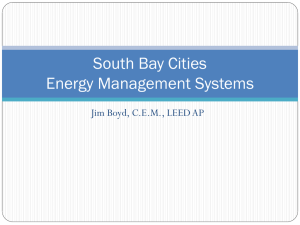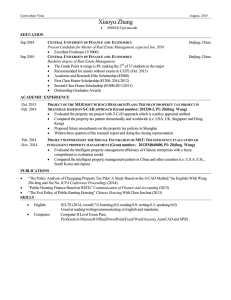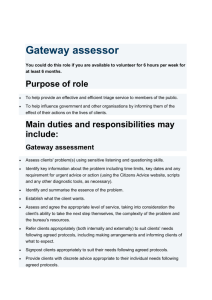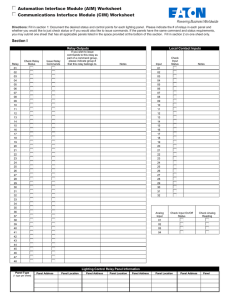Integration of Communication in Intelligent Buildings
advertisement
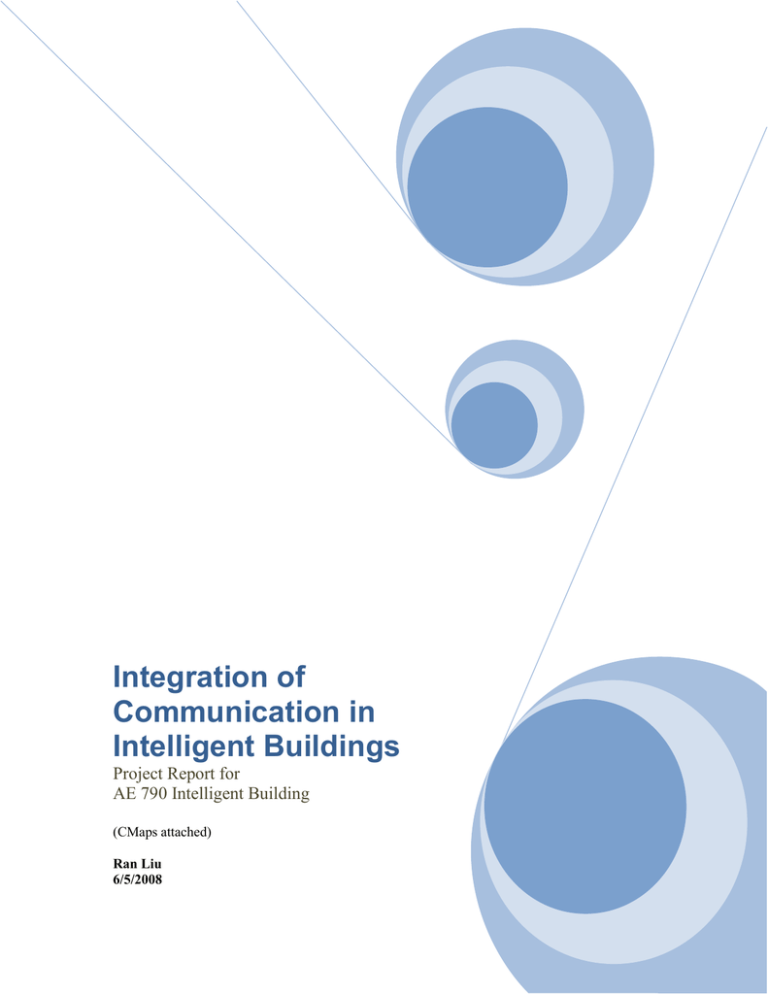
Integration of Communication in Intelligent Buildings Project Report for AE 790 Intelligent Building (CMaps attached) Ran Liu 6/5/2008 Table of Contents Overview ............................................................................................................................. 2 Network Architecture.......................................................................................................... 3 Gateway .............................................................................................................................. 4 Uniform Protocols ............................................................................................................... 5 BACnet ........................................................................................................................... 5 LonMark ......................................................................................................................... 6 Integration at Management Level ....................................................................................... 7 Open Process Control ..................................................................................................... 7 Web Server Technology ................................................................................................. 8 Future Communication ....................................................................................................... 8 Conclusion .......................................................................................................................... 8 Reference ............................................................................................................................ 8 1 Overview Many components are related with an intelligent building. A group of topics have to be stated to show the overall understanding of intelligent buildings. When come to intelligent buildings, the topics needed to consider include building systems, applied building types, objectives, related people, what are being controlled and how to make a building intelligent. But the most important question is what an intelligent building is. To my understanding, the ‘intelligence’ here means the ability to automatically deal with problems or maintain current conditions in buildings based on the previous data and human commends to achieve the objectives of saving energy and comfort indoor environmental quality. The way to make a building intelligent to run the building under control and communication system, widely called Building Automation System (BAC), or Energy Management and Control System (EMCS) by ASHRAE. According to ASHRAE definition, EMCS is a computer/processor based hardware and software system with sensors, control devices and all the necessary components that perform some or all of the following functions: 1 Measures (energy related); 2.Monitors and/or controls; 3 Reports status, information about buildings environment, energy efficiency, and HVAC system maintenance. From the technology point of view, the control and communication are key parts in an intelligent building. The control strategies include proportional control, two position control, and modern control technologies such optimal control, fuzzy logic control and neural network. The optimization of building system is achieved when the appropriate strategies are used. The communication network is also necessary to build up based on the growing information technology. Basically, there are three levels in communication system architecture. The highest level is Intranet and TCP/IP network system with human interface such as computers. The second level is peer-to-peer controller local area network and the third level is a polling or managed secondary controller network. In order to ensure communications among different devices under different levels, the communication protocols come to play. Closed protocols and open protocols are developed by manufacturers which are different from one to another. The standard protocols (BACNET) are developed by organizations like ASHRAE to improve the system standardization. Some problems existing in network communication systems will be described latter on. Once the EMCS are built up, all building systems will be under control. The major building systems include heating, ventilating, and air conditioning (HVAC), lighting system, fire protection, safety and security, hydraulic and drainage, and vertical transportation system. 2 During the design, management, operation and maintenance of an intelligent building, many people are involved in. the contractors and owner are in charge of building and managing. The indoor conditions will be adjusted based on users’ requirements. Basically, the satisfied indoor environmental quality is obtained by monitoring and controlling indoor temperature, relative humidity, indoor air pollutant and luminosity. Adjusting these parameters is not only for residential purpose, but also for commercial and industrial processes such as cargo storage and manufacturing process. Network Architecture As it is mentioned above, there are three hierarchies in BACS network. More specifically, they are field level, automation level, and management shown in Figure 1. At the field level, the network is physically connected to controlled terminals, such as switches, motors, lights, and sensors. Environmental data (temperature, humidity, etc.) are measured and collected. The data then will be transferred to the upper level as a signal (analog / digital) for analysis and processing. Meanwhile, these terminals are being controlled by the upper level with respect to the whole system response. The automation level is doing the automatic control work. It conducts the logical analysis on the data collected from the field level and makes the control strategies to take actions on the field level. Two types of communication are taking place on this level. One is horizontal communication with other ‘peers’ on the same level, the other one is vertical communication with management level. The management level is the decision-making level with human interface working through. It has access to the entire network system. An amount of historical data is storage here for comparison and analysis. Schedule and alerts are generated from this level. The modification to the system can be done either manually or automatically. (Kastner 2005). With the development of technology, some devices on field level, such as the sensor with microprocessor installed, can also do some analysis work. Therefore, the automation level and the field level are often integrated as a sub-system, and the management acts as a backbone network. (Figure 2) It is functional that three different hierarchies with every component people need are working together to achieve automatic building control. But the communication problems occur in this system. Because each device in the system is normally configured with a certain communication protocol generated by different manufactures, the controllers, sensors, workstations cannot understand each other. Therefore, the data transmission is disrupted. The communication solution is necessary to ensure the entire network working well. 3 Figure 1: Hierarchies of typical network Source: (Kastner 2005) Gateway For a building in which the devices with different protocols already exist, the gateway is simply and effective solution for communication integration. Gateway acts as a “translator” between devices, converting one protocol to another protocol. With the help of gateway, the data and signals are able to transmit correctly. As it is shown inFigure 2, four sub-systems including HVAC control, fire safety, security and access control, and lighting control are connected to a backbone network. Each sub-system is doing its job well. But their protocols are all different. To achieve the integration for the entire system, gateways are necessary to convert the protocols to what the backbone system can understand. Any two sub-systems can also “talk” to each other though management software. (Wang 2004) 4 Figure 2: Gateway applicaton Source: (Wang 2004) Gateway is an effective solution for such kind of network system. However, there are some drawbacks of using gateway. First of all, much effort and configuration is needed to map data exactly from one protocol to another one. There is no standard gateway since it is design for working between two certain devices. So the gateway is normally very expensive. Second, because gateway plays a role in between the communicating devices, the response time increases. Moreover, the controllers often need to be programmed though the management level, but it is difficult to do so with a gateway in the middle. (Wang 2004) Uniform Protocols A better solution for building network communication is to apply a uniform protocol to all levels and all devices. Hence, all components in the network are “talking” in the same language. Data transmission is no longer a problem. The main open protocols that are widely adopted include BACnet, LonWorks (LonMark), and EIB/KNX. They all have taken a place in worldwide market. (Wang 2004) BACnet BACnet is a standard protocol developed by American Society of Heating, Refrigerating, and Air Conditioning Engineers (ASHRAE) for building network communication. It has been American national standard, ISO global standard, and European pre-standard (Wang 2004). BACnet utilizes the Open System Interconnection (OSI) model as the reference. OSI is an international protocol standard for multi-vendor computer communication. It breaks the problems in communication between computers down to seven smaller problems, each of which works as a certain communication function. BACnet uses only 5 four layers to reduce unnecessary tasks and then achieve an accepted building communication network(Wang 2004). BACnet defines both the standard and the expected behavior. Nowadays, many automation systems available in the market are interoperability with BACnet. (Kastner 2005) It is easy for BACnet-device to connect with Intranet and Internet. One way to do this is using BACnet/IP Packet-Assembler-Disassembler (PAD) router. PAD is mounted in every BACnet network which is to be connected to IP network. It can transfer the BACnet message to UDP/IP message with IP address then sends it out. Another PAD receiving the message will change the message back. (Figure 3) The other technology is to define a new protocol layer called the BACnet Virtual Link Layer to send broadcast message. The device now is allowed to enter network from any point in IP network (Wang 2004). The interoperability with IP network is the key feature of BACnet to be adopted widely. Figure 3: BACnet and IP network Source: (Wang 2004) LonMark LonMark is a protocol developed by LonWorks. Compared to BACnet, it is good at solving interoperability at the component level inside a local network. A comparison of BACnet and LonMark is listed in Table 1. Obviously, the feature of LonMark is limited. But it can provide an efficient local network (Kastner 2005). 6 Table 1: Comparison of BACnet and LonMark Source: (Wang 2004) Integration at Management Level Integration at management level is the higher application of the network communication. Not only the integration of different BACs, but also the integration of BACs and the office network can be achieved under this application. The popular technologies are OPC and some web service (Kastner 2005). Open Process Control The application of open process control (OPC) is shown in the Figure 4. The OPC server combines different BACs network including BACnet and LonMark, and Web server and Intelligent Building Management System (IBMS). Then any two points in this application can visit each other. (Wang 2004) Figure 4: OPC application Source: (Wang 2004) 7 Web Server Technology The web server technology for integration at management level includes XML, Universal Description, Discovery and Integration (UDDI), Web Service Definition Language (WSDL), Simple Object Access Protocol (SOAP). They are designed based on the existing Web technologies and more powerful. (Wang 2004) Future Communication Obviously, it is expected that all devices in the building network will communicates using only one protocol. Even if some devices have to work with a different protocol for working performance reason, they should have ability to translate to standard protocols automatically and immediately. Moreover, the building system is expected to communicate with human more efficiently by displaying graphic information, analyzed recommendation, and even talking. Conclusion Several solutions are available for building network communication. Gateway is the simple solution for existing systems. Using the uniform protocols is the better solution for communication. The integration at the management level improves the interoperability of different BACs networks with IP networks. Reference Kastner, W., Georg Neugschwandtner, Stefan Soucek, And H. Michael Newman (2005). "Communication Systems for Building Automation and Control." IEEE VOL. 93, NO. 6,. Wang, S., Zhengyuan Xu, Heng Lib, Ju Hongb, Wen-zhong Shi (2004). "Investigation on intelligent building standard communication protocols and application of IT technologies." Automation in Construction 13 (2004) 607– 619. Johnny Wong, Heng Li (2005), Development of a conceptual model for the selection of intelligent building systems, Building and Environment 41 (2006) 1106–1123 Li-Chen, Fu and Teng-Jei, Shih (2000), Holonic Supervisory Control and Data Acquisition Kernel for 21st Century Intelligent Building System, International Conference on Robotics & Automation 8
